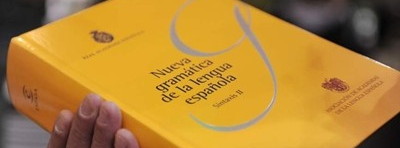 télico
télico
A concept that crops up frequently in Spanish grammar is the idea of telicidad. This term classifies the predicate (the verb and other elements telling us what the subject does or is- read more) as events that either have a natural endpoint (predicado télico), or don't (predicado atélico).1
'Telic' predicates are delimited, and they must reach completion in order to be considered to have happened.
'Juan compone música' is an activity that has no clearly defined end; it is atelic. Whether Juan composes music for a second or a year, we can say that the event has indeed happened.
'Juan compuso una sinfonía', however, does have a clear ending. In other words, if Juan doesn't finish composing the symphony, then the event never happened.
"Se identifican como ‘télicos/as’, bien las acciones, bien los verbos o sintagmas verbales que los designan, que implican la consecución de un objetivo para que pueda decirse que tal acción ha tenido efectivamente lugar. «Correr los 400 mts. vallas», por ejemplo, es un sintagma verbal que alude a una acción ‘télica’: si alguien comienza a correr los 400 mts. vallas pero abandona la carrera una vez pasada la primera valla, sin concluir el recorrido, la acción de «correr los 400 mts. vallas» no se ha realizado. En cambio «andar» no designa una acción ‘télica’. Si alguien comienza a andar y se interrumpe al momento de haber iniciado su actividad, ya podrá decirse que la acción de «andar» ha tenido lugar”. 1
One way of telling if the predicate is telic or not is to try the verb in the pretérito indefinido (canté): 'Ayer compuso una sinfonía' –this is a complete action.
'Ayer compuso música', meanwhile, may sound incomplete.
Since continuous tenses indicate that an event or activity is in progress, and hence incomplete, 'ayer estuvo componiendo música' usually sounds better.
"El pretérito perfecto simple [el indefinido] es compatible con los predicados télicos porque estos tienen un rasgo interno de delimitación".2
However, in practice, many verbs and predicates can be viewed as telic or atelic, depending on the perspective of the speaker/listener and the context. 'Sonar el teléfono', for example, may be viewed as telic or atelic when used in the past:3
-De repente sonó el teléfono [comenzó a sonar]
→Sonó el teléfono [una vez]
→→Sonó el teléfono durante toda la mañana [Verbo semelfactivo]
Telic events are often compatible with the preposition 'en', while atelic predicates can be made telic by adding the preposition 'durante', e.g. compuso una canción/terminó el discurso (en una hora) vs. compuso música/caminó durante una hora. [See aspecto léxico] Some verbs are compatible with both:
"En efecto, verbos como 'adelgazar', 'aprender', 'empeorar', 'envejecer', 'mejorar', 'madurar' o 'progresar' denotan procesos que pueden concebirse como télicos o atélicos con igual naturalidad".4
Aprendí ruso (en 6 semanas) [Alcancé cierto estado de aprendizaje; una realización]
→Aprendí ruso durante 6 semanas [Estuve 6 semanas aprendiendo ruso; una actividad sin fin]
Adelgazó (en 2 días) [Alcanzó cierto estado de delgadez; una realización]
→Adelgazó durante 2 días [Estuvo 2 días adelgazando; una actividad sin fin]
Whether the predicate is telic or not influences how it is used in many grammatical constructions.
The present
As discussed in el presente progresivo, Spanish often uses the present simple to talk about events in progress at the time of speaking. Some verbs/predicates are more frequently used in the present simple (e.g. ¿te ríes de mí?) than the present continuous (e.g. estoy trabajando) to refer to temporary events in progress. In general, those activities that have no clear endpoint (atélico) are used more in present continuous in order not to be confused with permanent facts, habitual actions, or cyclic events.
"Los textos muestran que «estar + gerundio» se usa de forma preferente con verbos que denotan actividades, es decir, eventos sin límite natural, como en 'estuvo (esperando - lloviendo - manejando - mirando - pensando - trabajando - viviendo)'".2
To take a topical example, the war in Syria is much talked about in the media and at home. This is an ongoing conflict, but where in English we would usually use the present continuous (except in news headlines), in Spanish you will often find the present simple used to refer to events in progress or recently completed.
'Los sirios huyen de la guerra'.
This is an event that can be considered telic, because there is a start and an end. We can confirm this by conjugating the verb in the pretérito indefinido: 'los sirios huyeron de la guerra' tells us that they fled and that event reached completion.
Compare the above with the sentence, 'Mi padre trabaja en un proyecto'. This is atelic –it is open-ended. 'Mi padre trabajó ayer en un proyecto' sounds incomplete. 'Estuvo trabajando en un proyecto', meanwhile, usually sounds better. So, we are far less likely to use this atelic predicate in present simple unless we are referring to a permanent fact like 'mi padre trabaja en un proyecto para la NASA' (his job). If we want to refer to a temporary event in progress, however, we would more likely say 'mi padre está trabajando hoy en un proyecto' than 'trabaja hoy en un proyecto'.
The Past
Atelic predicates, which are not delimited, are more likely to be used in the imperfect (cantaba), rather that the preterite (canté).
However, atelic predicates can be used in the preterite when they are delimited externally by a period of time, either explicit or implied. Use of the preterite in these cases may refer to the entire period of time or the inicial limit.
"El predicado 'vivir en Caracas' es durativo o atélico porque no posee delimitación interna, a diferencia de 'viajar a Caracas'. Sin embargo, las situaciones atélicas admiten límites por el simple hecho de que no perduran de forma indefinida. Poseen, por tanto, inicio y final; es decir, están limitadas EXTERNAMENTE por la extensión temporal que ocupan".3
-Viajé a Caracas (telic with internal delimitation)
→Viví en Caracas ('vivir en Caracas' is atelic, but it is made telic by adding or inferring a period of time)
-El dormitorio daba al patio ('dar al patio' is atelic; the imperfect is the most natural choice without context that delimits it)
→El dormitorio dio al patio (we infer that 'dio al patio durante x tiempo')
-Conocía a Juan ('conocer a Juan' is atelic)
→Conocí a Juan (with the preterite we refer to an initial limit -interpretación incoativa/ingresiva4-5)
Others
The notion of telicidad also comes into play when using the verbal phrase ir + gerundio (see discussion). In general, this type of construction is more common with telic events.3
Since ir + gerundio often indicates cumulative and incremental progression, it implies some end point or completion, e.g. el árbol fue creciendo, los muebles se fueron acumulando have a natural limit which can be seen by using the pretérito indefinido: el árbol creció (complete event); los muebles se acumularon (there is a start and and end).
When referring to an activity without a natural limit (atélico), ir + gerundio often doesn't work:
Te estuve esperando
Te fui esperando??
The use of the intensive se (see se aspectual) is also influenced by telicidad. It is generally only used when referring to a defined amount of something or a complete event rather than an unspecified open-ended activity.4
El niño comió manzanas (atelic activity)
→El niño se comió dos manzanas (telic event)
El niño se cayó

